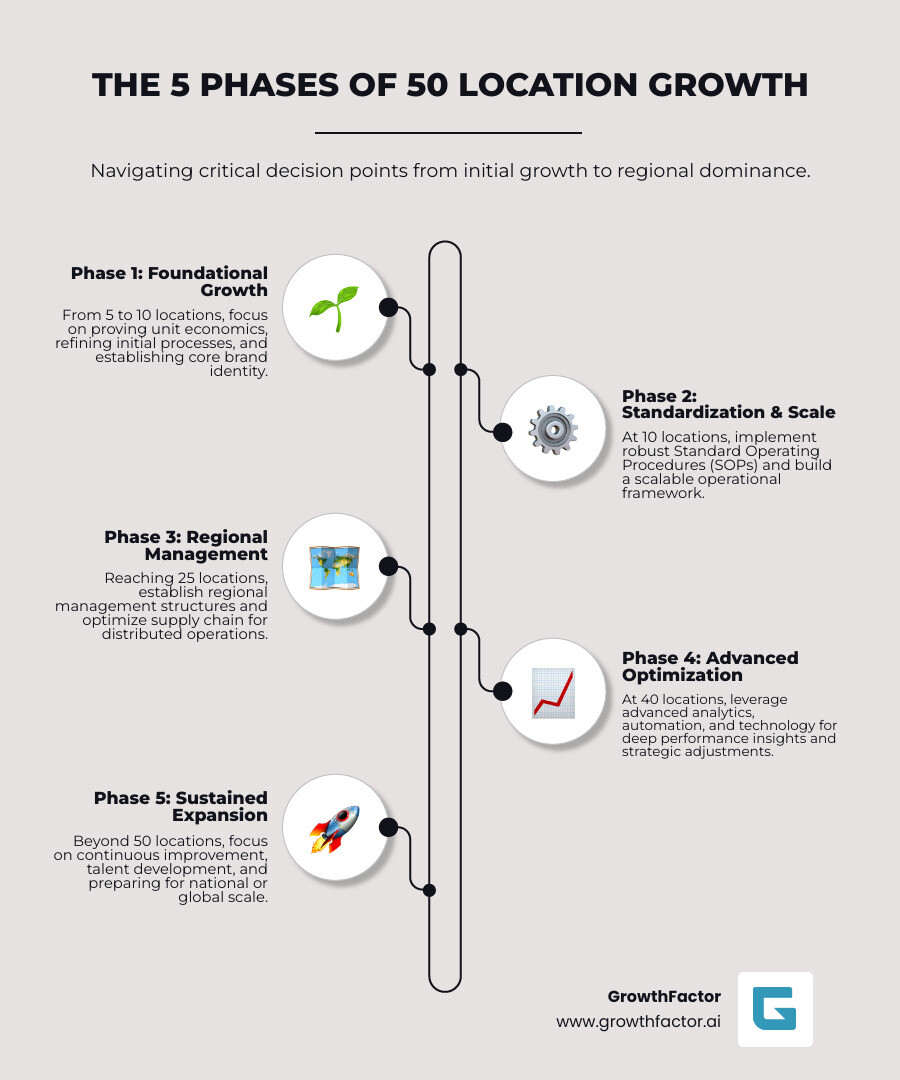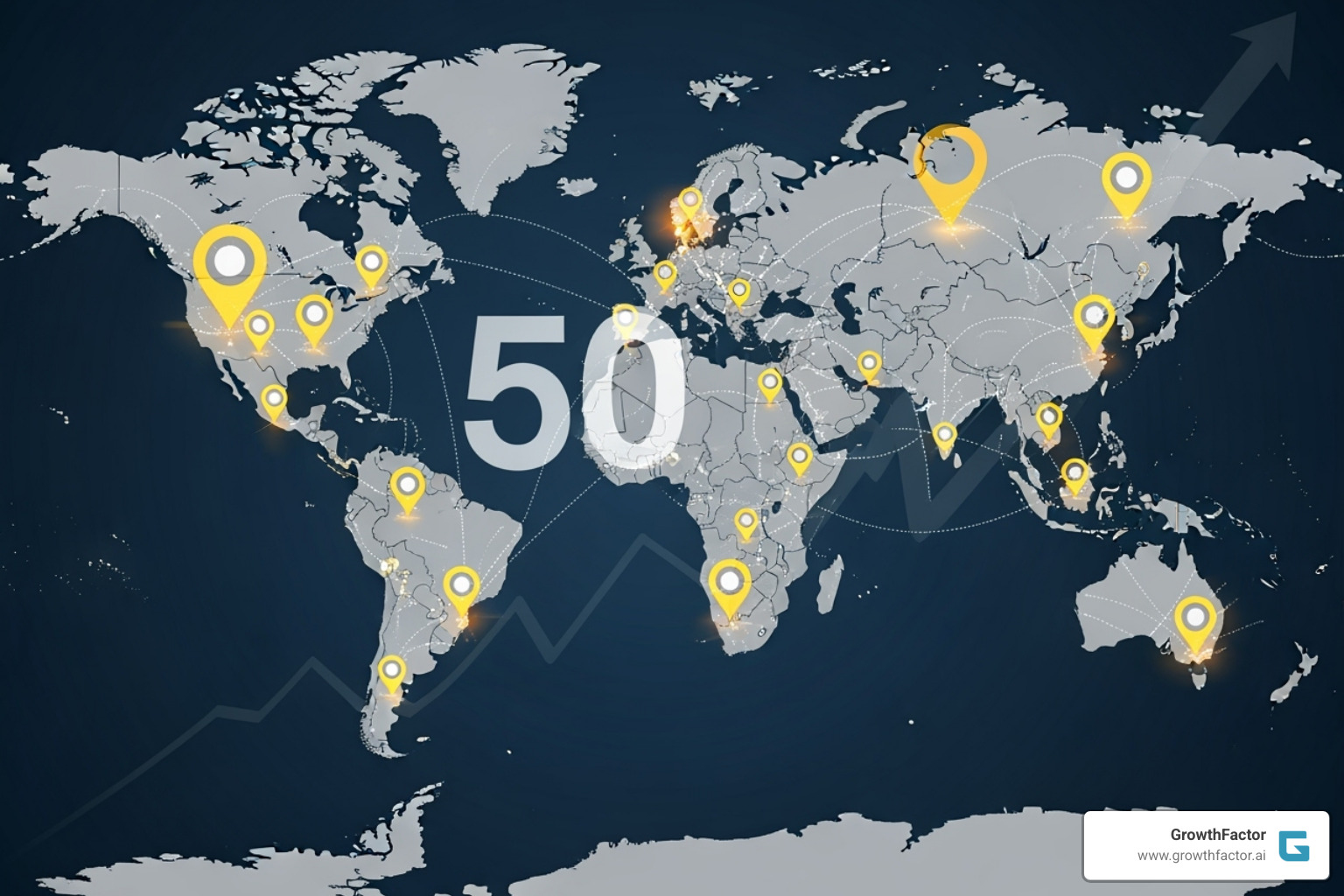Detailed Guide to 50 Location Growth Strategy
From One to Fifty - The Scaling Challenge
A 50 location growth strategy is an ambitious milestone for expanding retail chains, involving systematic scaling through careful planning and operational excellence. The path from 10 to 50 locations is where many chains either achieve regional dominance or fail. Research shows 70% of startups fail due to premature scaling, while those that steer this phase successfully can outpace competitors by 2-3x.
Success requires a solid foundation built on data-driven site selection, financial planning, scalable operations, talent development, risk management, and performance measurement. For example, Cava's growth from 105 locations in 2020 to over 230 by 2023 demonstrates strategic scaling done right, balancing aggressive expansion with operational discipline.
The challenge isn't just opening stores; it's building the infrastructure to manage 50 locations profitably while maintaining brand consistency.
I'm Clyde Christian Anderson, Founder and CEO of GrowthFactor.ai. I've helped retailers like Cavender's Western Wear triple their expansion pace, with 27 new stores all meeting revenue projections. My experience shows that a well-executed 50 location growth strategy requires sophisticated planning and the right technology to succeed.

The Core Pillars of a Successful 50 Location Growth Strategy
Building a 50 location growth strategy requires a foundation that can support sustainable, profitable growth. Through years of helping retailers scale, we've identified six essential pillars that separate companies that thrive from those that struggle.
Pillar 1: Data-Driven Site Selection and Market Analysis
The old mantra of "location, location, location" has evolved to "data, data, data." Smart site selection requires a deep understanding of your market, combining demographic data (who customers are), psychographic data (what motivates them), and traffic patterns. A thorough competitive analysis is also crucial.
This data feeds into site selection models that predict a location's potential success. This is where AI in site selection becomes a game-changer. Our AI Agent Waldo enables teams to evaluate five times more sites efficiently by automating the qualification process. Instead of spending weeks on a few locations, you can rapidly assess dozens with greater accuracy.
For deeper insights, check out our guides on Data-Driven Site Selection and Retail Location Analysis.

Pillar 2: Financial Planning and Funding for Expansion
Aggressive growth requires significant funding, and undercapitalization is a primary reason expansion strategies fail. Your capital requirements must cover not just opening costs but also extended cash burn periods, with a recommended runway of at least 6-9 months.
Solid unit economics—like average store opening cost and time to profitability—are critical before scaling. Be aware of hidden costs from multi-unit expansion, including increased corporate overhead, regional management, supply chain complexity, and new technology infrastructure. Effective cash flow management is essential to track and optimize finances across your entire 50-location network.
For more detailed insights, explore our Sales Forecasting Tips for Retail Site Selection. We offer flexible plans—Core ($500), Growth ($1,500), and Enterprise options—to support businesses at different stages.
Pillar 3: Building a Scalable Operational Framework
A scalable operational framework ensures a consistent customer experience across all 50 locations. This is built on brand consistency, enforced by detailed Standard Operating Procedures (SOPs) for all key activities.
Your supply chain logistics must be optimized for a 50-store network, from supplier relationships to distribution. The right technology stack acts as your central nervous system, with centralized POS, CRM, and automated reporting tools to drive efficiency.
Anticipate "stair step growth" by building infrastructure that can handle 5-10x your current volume. This prevents capacity bottlenecks from derailing expansion. The goal of operational efficiency is to create systems that scale, making your 50th location easier to manage than your 5th.
Learn more in our Retail Expansion Planning Software guide, and dive deeper with this HBR article on growth strategy.

Pillar 4: Talent, Training, and Culture for a 50 Location Growth Strategy
Your people are your most valuable asset in a distributed 50-location network. A robust talent acquisition pipeline is needed to handle rapid workforce growth. Companies maintaining cultural coherence see 30% higher employee retention.
Standardized training programs must go beyond procedures to instill brand values and vision. Leadership development is also crucial for creating strong regional and local managers, ideally by promoting from within.
Maintaining company culture across dozens of locations is a major challenge. It requires clearly defined values and technology to keep teams connected. Strong employee retention, driven by competitive compensation and a positive employer brand, directly impacts your bottom line. Finally, performance management systems ensure your investment in people pays dividends as you scale.
For insights on why strategies sometimes fail, check out this resource: Why good strategies fail: Lessons for the C-suite.
Pillar 5: Marketing, Customer Engagement, and Risk Mitigation
With 50 locations, your marketing must balance national brand awareness with local community connection. Localized marketing is essential, using geo-targeted ads and local events. A strong digital strategy for multi-location businesses drives online traffic to physical stores via local SEO and personalized promotions.
Customer loyalty programs build relationships and increase customer lifetime value. However, rapid expansion requires careful risk assessment. Key risks include premature scaling, undercapitalization, operational bottlenecks, cultural fragmentation, and competitive response. Proactive risk mitigation involves maintaining financial reserves, stress-testing systems, and using data to make informed, flexible decisions.
For a deeper dive, explore Scale or Stall: Why Retail Expansion Hits a Wall at 50 Locations (and How to Break Through).

Pillar 6: Measuring Success for Your 50 Location Growth Strategy
Measuring success for a 50 location growth strategy goes beyond counting stores; it requires tracking Key Performance Indicators (KPIs) for the entire network's health.
Key metrics include:
- Unit-level profitability: The goal is 50 profitable locations.
- Customer Acquisition Cost (CAC) & Lifetime Value (LTV): Aim for a healthy LTV:CAC ratio of 3:1 or better.
- Same-store sales growth: Indicates the health of your existing business.
- Market share and customer satisfaction: Crucial for growth and retention.
- Employee retention and operational efficiency: Happy employees and optimized operations drive profitability.
The "stair step growth" concept reminds us that profitability trumps location count. Sometimes, improving an existing store is more valuable than opening a new one. Use iterative adjustments based on performance data to ensure sustainable growth. If a location underperforms, investigate and adapt. Centralized reporting allows you to track targets, analyze behavior, and replicate best practices across the network.
For more insights, explore our guide on Store Location Analytics.
Conclusion: Executing Your Expansion with Confidence
The journey to a 50 location growth strategy is about building a remarkable, lasting business. The six pillars we've explored are the battle-tested foundation for successful scaling, from data-driven site selection to scalable operations.
However, execution is everything. A perfect strategy is worthless without consistent implementation. That's why we built our AI-powered platform with AI Agent Waldo—to bridge the gap between planning and flawless execution. Our technology handles the heavy lifting of site evaluation, freeing you to focus on building your brand and serving customers.
Successful strategy execution requires both a long-term vision and the flexibility to adapt to market changes. Continuous improvement is your competitive advantage; use insights to get better, not just bigger.
At GrowthFactor, we help retailers turn expansion dreams into profitable reality. Our platform provides the confidence to make data-driven decisions, whether you're planning your first expansion or your next 20 locations. With the right tools and partner, you can execute your 50 location growth strategy with confidence.
Ready to accelerate your growth? Find out how we support For Emerging Multi-Unit Retailers and take the next step.
Citations
The human algorithm
Request a live demo
Schedule meeting
Or submit your information below and we'll be in touch to schedule.



